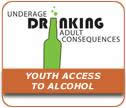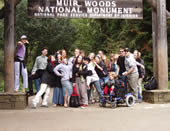Teen Driving in Alaska
Teen Driving in Alaska
Every year teens account for approximately 20% of the fatalities and major injuries that occur on Alaska's roads and highways. Nearly half of these deaths can usually be prevented by simply buckling-up or not drinking and driving.
This off-site web page has been set-up to offer teens and parents some suggestions for driving safely.
Teen Driving Safety
A
Comprehensive Approach to Teen Driver Safety ![]()
NHTSA designed this site to provide you directly with resources & information you'll need to promote what research clearly shows reduces teen crashes:




Under Your Influence - Visit NHTSA's Media-Ready ads aimed at parents of novice drivers ![]()
Drinking and Driving
A recent study compared Alaska's 1995-1999 minor consuming cases with 1995-2006 DUI court cases and "found that 24.4% of youth with minor consuming arrests go on to have DUI offenses before their 31st birthday".
Evaluation of Risk Factors for Repeat DUI Offenses ![]() (210 KB)
(210 KB)
In 2009 the Alaska Interagency Coordination Committee on the Prevention of Underage Drinking published Alaska's Plan to Reduce & Prevent Underage Drinking ![]() (1 MB)
(1 MB)
Prescription Drug Abuse
Though overall teen drug use is down nationwide, more teens abuse prescription drugs than any other illicit drug, except marijuana—and more than cocaine, heroin, and methamphetamine combined. However, research shows that many parents are not aware of teen prescription drug abuse and are not discussing the dangers with their teens. To address this serious trend, the White House Office of National Drug Control Policy (ONDCP) today announced its first major federal effort to educate parents about teen prescription drug abuse. This national public awareness campaign will begin with advertising during this year´s Super Bowl, and includes broadcast, print, and online advertising, community outreach, and new print and online resources to help parents and communities combat the troubling trend of teen prescription drug abuse.
- Prescription
Drugs Television Ads

- Prescription
Drug Abuse Pamphlet

- National
Report on Prescription Drug Abuse

Flyers
- Drivers set the rules
 (1.3 MB)
(1.3 MB) - Be a good passenger
 (1.2 MB)
(1.2 MB) - Tell passengers to Just Chill
 (1.8 MB)
(1.8 MB)
Driving
The Deadliest Driving Season for Teens
From proms, graduation parties, and the start of summer vacation, MADD discusses tips on keeping Teens safe on the road ![]()
Teensurance
Introduced and offered through SAFECO, Teensurance is an option for policy holders that provides a range of ways to keep teen drivers safer. "It’s all about providing parents peace of mind while teens earn their freedom." These options include:
- Roadside
assistance for your teen driver

- Safety
Beacon™ convenience and protection for one
vehicle

- 100 free starter credits for notifications**
- Free installation by a local professional

- One free TeenDASH
for Safety™ Assessment, plus unlimited discounted
assessments

In Alaska, the Teensurance GPS tracker may have limited ability in bad weather situations and in dense forested areas or mountain ranges. It is recommended for use by citizens in Anchorage, Mat-Su, the Kenai Peninsula and Fairbanks, although anyone can set-up a policy. Policy set-up options can be found by contacting your local insurance agent or calling a SAFECO representative at 1-866-507-8336.
 Alive at 25® Parent Program Online
Alive at 25® Parent Program Online ![]()
The National Safety Council®'s Alive at 25 ® Parent Program Online prepares parents to partner with their teens to develop safe, responsible driving behaviors. It's the online version of the successful Alive at 25 ® Parent Program classroom course.
Aegis Mobility
Aegis Mobility is offering a new technology that will permit cell phone subscribers (parents and employers) to block or manage cell phone activity, such as talking or texting, when a teen or mobile employee is driving, eliminating a leading cause of driver distraction.
The Aegis Solution is a network-based
service that will be available through wireless service
providers, similiar to voicemail or caller ID. The Aegis
software automatically detects when the wireless device
is in motion. When in motion, the service is automatically
initiated to act as your personal assistant in managing
incoming/outgoing calls/texts.
Aegis Vice President Mandy Chan can be reached at (604) 899-1008 x102
Graduated Drivers License Program
In 2004 the Alaska State Legislature started a Graduated Drivers License (GDL) program by creating a system where young drivers can pursue their full, unrestricted driver's license. Before this, Alaska only required a driver under 18 to obtain a learner's permit for 6-months before testing for a driver's license. This program has added several important protections for a new driver that relates to when they can drive, where they can drive, and with whom and how.
- At age 16, a person may be
eligible for a Provisional License when:
- That person has held a learner's permit for 6 months,
- A parent or guardian certifies that this person has performed at least 40 hours of driving, including 10 hours of driving under challenging conditions such as nighttime or harsh weather conditions, and
- This person has not been convicted of violating a traffic law for at least 6 months before applying.
- Once the youth holds a Provisional
License, they are subject to several limitations for
the first 6 months of driving. They must:
- Driving between 1:00 and 5:00 a.m. is prohibited except when driving to and from a job or in an emergency situation
- Generally no passengers except for: Passengers who are 21 yrs or older or siblings of the driver
- Passengers when accompanied by the driver's parent or legal guardian.
- 6 months after a Provisional
License is issued, the youth may apply to the Division
of Motor Vehicles (DMV) for an unrestricted license:
- As long they have not been convicted of a traffic offence for at least six months before their application.
Two important exceptions to this law:
- A driver with a Provisional License may be eligible for a work permit so that they can drive to or from work or drive during the entire time they are employed.
- Driver's issued permits or licenses under the DMV's hardship or off-systems licensing programs are in no way affected by the GDL licensing provisions.
The Graduated Driver's License is a means for a young driver to gain experience on the road while minimizing risks. As a driver gains experience, the provisions are gradually removed and the youth is eligible for an unrestricted or full driver's license.
Since the National Transportation Safety Board adopted its graduated driver licensing recommendations in 1993, states have dramatically modified their driver licensing practices. Since 1993, the 38 states that have adopted comprehensive GDL licensing systems have reported great reductions in the fatality rates of teen drivers and passengers. In California, teen passenger deaths and injuries when 16-year-olds are behind the wheel dropped 21% statewide in 1998 and 1999. These results come two years after the passage of California's GDL. Florida, which adopted a GDL program in 1997, saw a drop of 21% in the rate teens are involved in traffic crashes.
Research published in October 2001 from Michigan and North Carolina, two states with comprehensive laws that include both an extended learners' permit phase and a nighttime driving restriction reaffirms the effectiveness of graduated licensing. In Michigan, research shows that 16-year-olds were 25% less likely to get into a crash; in North Carolina, the risk of a crash dropped by 23 %. Further, in North Carolina, nighttime crashes involving 16-year-olds declined by 43% and fatal crashes dropped by 57 %.
The goal is to limit teen exposure to risky driving situations during their first few months of licensure, a time when their crash rates are extremely high. Parents indicate strong support for GDL and for the specific restrictions. Graduated licensing will save young lives in Alaska, guaranteed!
Links and Statistics
- Chugiak High School, Every Fifteen Minutes - Procedural Manual for Mock Crashes
 (6.4 MB)
(6.4 MB) - Ad Council: Youth Reckless Driving Prevention

- Teen Tracking.com

- 2002-2008 Crashes Involving Cell Phone Use
 (86 KB)
(86 KB) - National Teen Driver Safety Week

- House Bill 15A: An act relateing the use of cellular telephones by minors when driving a motor vehicle; and providing for an effective date
 (8 KB)
(8 KB) - Under Your Influence - NHTSA's Media-Ready ads aimed at parents of novice drivers

- Cartasite - devices to measure rapid acceleration, hard braking, and erratic lane shifts

- Alaska Youth Risk Behavior Survey Graphs
 (3.1 MB)
(3.1 MB) - Young Driver Policy Brief - University of Iowa, Public Policy Center
 (369KB)
(369KB)
Safety Topics
- DEC / DRE
- Distracted Driving
- Fatality Analysis Reporting System (FARS)
- Headlights
- Media Campaigns
- Occupant Protection
- DUI Information & Impaired Driving
- Senior Driving in Alaska
- Teen Driving in Alaska
- Traffic Records


